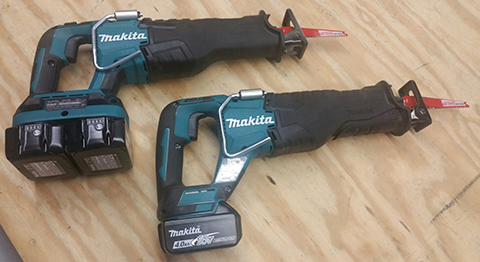A little over a year ago Makita relaunched 3 new cordless reciprocating saws that would work on their 18V LXT platform in the XRJ04Z ($119) which was utilizes a brushed motor and designed as entry level price point cordless recip. To compete with the Milwaukee M18 FUEL Sawzall, Dewalt FlexVolt, Hilti and others to come they needed a powerful brushless model that had corded power and solid runtime. Do they use their 18Vx2 platform or use a single battery that’ll be a little less powerful. In this case Makita said let’s do both and let the people choose between the very similar 18V XRJ05Z ($199) and 18Vx2 XRJ06Z ($219).
Having spoken to several larger Makita dealers, users have been predominantly choosing to purchase the single battery XRJ05Z, estimates 5:1 to as high as 10:1 ratio. Why are so many people buying a less powerful saws? In talking with folks that were making the purchases it became clear, it’s very hard to tell how much more power, if any, you gain by going to the 2 battery saw. Makita, nor any other cordless tool manufacturer provide a good power output for saws in torque, watts, amps or any other power rating. The stroke length and strokes per minute are the only stats you get and are identical for these two saws. From the box’s stats they look identical except the added pain of needed twice as many batteries and possibly a duel bay charger, no thank you.
We recently conducted some comparison testing with a handful of brushless recip saws including both of these Makita models as well as Dewalt FlexVolt with 9.0Ah, new Bosch 18V brushless GSA18V-125 with 6.3Ah CORE and Milwaukee M18 ONE-KEY Sawzall with 9.0Ah. Before everyone goes off on it’s not fair to compare a 9.0Ah vs a 6.3Ah vs a 4.0Ah, you are correct if the main concern was battery life however we are not going to get apples to apples in battery life if they don’t all have 9.0Ah (not going to anytime soon). We are seeing new battery technology which may allow for more max power output of a tool, Ah rating does not factor into peak power, if anything higher Ah can actually mean lower peak watt output.
The full comparison for all these saws is coming soon but for many Makita 18V LXT cordless users the big question is really, do I want a XRJ05 or XRJ06. We ran them all through a few basic tests, the two that were most telling here are the timing cuts between cutting wood 2×4 material and ¾” black pipe, we made 5 cuts with each saw using brand new Freud Carbide Blades and here are the results:
Makita 18V Recip XRJ05
Wood Cuts: 3.05, 4.00, 3.31, 3.30, 3.60 (3.452 sec)
Black Pipe: 1.91, 3.16, 3.01, 3.60, 3.45 (3.026 sec)
Makita 18Vx2 Recip XRJ06
Wood Cuts: 2.73, 2.92, 2.81, 3.00, 2.85 (2.922 sec)
Black Pipe: 2.35, 2.25, 2.40, 2.46, 2.78 (2.448 sec)
With cut speeds roughly 20% faster we can pretty definitively say the XRJ06 is more powerful than the XRJ05 however neither slowed noticeably, nor stalled out even while cutting black pipe. Both saws have solid power and really felt almost the same in use.
While the saws are very similar in look, feel and design the XRJ06 obviously weights more, 8.3 lbs (one of the lightest) vs 9.9 lbs with the additional battery. We did find the runtime for the XRJ06 was very close to double (using 4.0Ah and 4.0Ah x2) which seems obviously but not always the case if the saw has a big power difference.
So which Makita 18V LXT Recip Saw should you buy, XRJ05 or XRJ06? We do feel now the 18Vx2 is clearly more powerful but is it enough to justify needing more batteries and more coordinating charge times? We like the flexibility to use multiple batteries for heavy duty tools and breakers but is it needed here? The single battery XRJ05 is a very capable recip saw that never really bogged down on us even in heavy applications, for our time and money it seems like the XRJ05 is the way to go.





